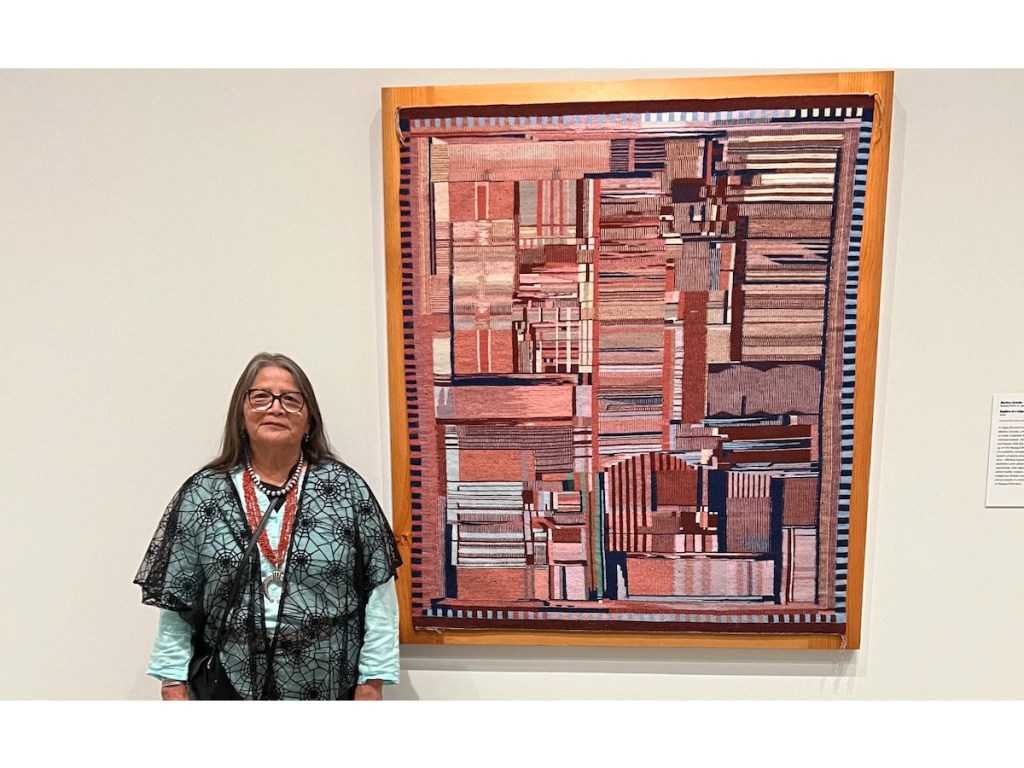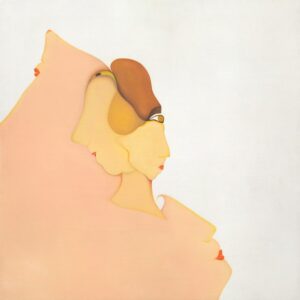The Diné Weaver Who Turns Microchips Into Art



MESA, Ariz. — In 1964, encouraged by subsidies from the Bureau of Indian Affairs and the Navajo Nation leadership, the Fairchild Camera and Instrument Corporation opened a large manufacturing plant in the northeastern corner of the reservation. The facility primarily employed Diné women to assemble microchips. These laborers were often characterized as being particularly adept at this kind of work due to “nimble fingers” and a history of producing intricate jewelry and weaving, racialized claims illuminated by contemporary scholars like Lisa Nakamura.
By the mid-1970s, the Fairfield plant had become the largest employer on the reservation, but it was also plagued by poor working conditions, low wages, and little job security. These issues came to a head when the American Indian Movement (AIM) occupied the plant in protest of a wave of layoffs. The plant eventually shut down.
A few years later, Intel began producing microchips in a new plant a couple of hours’ drive from the Navajo Nation. While the company’s negative environmental and social impact on the region has been extensively documented, Intel made a notable cultural contribution by commissioning fourth-generation Diné weaver and math teacher Marilou Schultz to create a weaving of a Pentium microchip in 1994. The project was technically demanding, requiring significant experimentation, and spurred Schultz to embark on a 30-year path of exploring new technologies through weavings, creating Diné textiles of digital graphs, QR codes, and four other microchips. Works in her microchip series were included by curator Candice Hopkins in Documenta 14 in 2017. Since then, she’s been featured in multiple international exhibitions, including Woven Histories: Textiles and Modern Abstraction on view at New York’s Museum of Modern Art (MoMA) through September 13.
Beyond these institutional exhibitions, though, Schultz has long been a central figure in Native art markets in the Southwest, where she has shown work alongside other Diné weavers such as her late mother Martha Gorman Schultz, sister Lola Cody, and niece Melissa Cody. She is widely respected for reintroducing the Diné wedge weave technique and for pushing the boundaries of Navajo weaving styles — transforming her pieces into sculptural forms filled with optical illusions and what she calls “special effects.”
At the markets, Schultz sometimes brings a photo album filled with decades of snapshots documenting her work across numerous series. This archive reveals a lifelong commitment to experimentation and innovation guided by Hózhó, a multifaceted Diné concept that roughly translates to balance, beauty, and harmony. I spoke with Schultz about the wide visual range of her work through interviews at her home studio in Mesa, Arizona, and a few Zoom calls. These conversations have been edited and condensed for clarity.
Zach Feuer: In the late 1990s, your untitled work reimagined a chief blanket by weaving it in three parts. This seems to engage ideas of deconstructing, valuable iconic forms, emphasizing the abstraction in Diné weaving, and challenging the functionality of the textile by creating a piece that exists purely as art. What was your thought process behind weaving it in three parts?
Marilou Schultz: I wanted it to be like a display, almost like a painting on a wall. That was the initial idea. Rather than having just one solid piece, I wondered why I couldn’t section it off into panels. That’s how the concept developed.
I considered different types of blankets. A first-phase chief blanket wouldn’t work because of its simple striped design. The second-phase blankets, with rectangular shapes in the corners, also wouldn’t lend themselves well to this approach. I even thought about monkey blankets, which I love, but their simplicity meant that rearranging the panels wouldn’t create much variation.
Eventually, I settled on a third-phase chief blanket because its design allowed for movement while still retaining its recognizable structure. I could make two narrower side panels and a larger central panel. By shifting these panels, the design would still be visible but could be rearranged in different ways. The other classic blankets I considered wouldn’t have had the same effect.
I wove all three sections at the same time. The result was beautiful. When photographed, the three panels could be displayed together or shifted into different arrangements. That’s also how I sold them — as a set of three pieces.

ZF: Was that the first piece you consciously created as a work of “art,” rather than a functional blanket or textile?
MS: Yes, I think so. All my other pieces were singular works that could still be seen as functional in some way. But with this piece, I intentionally approached it as an art object meant for the wall. It was never meant to be worn or used as a traditional textile. There was no way to put all the sections together as a functional blanket. It was purely an art form, designed to be viewed like a painting. That’s what made it special. As you know, it’s one of my favorite pieces.
ZF: Can you tell the story behind your first microchip painting?
MS: That project happened around 1996 because the rug itself was completed in 1997. Louis Baca, who worked with Intel in Chandler, was involved in organizing a conference where the theme was “Weaving and Technology.” As part of this event, Intel wanted to present a gift to ACES (the American Indian Science and Engineering Society), and Louis thought it would be meaningful to commission a weaving that reflected technology.
He came up with the idea of incorporating an Intel microchip design. At the time, he approached me about it, and I agreed without even knowing what the design looked like. I just knew it was going to be a microchip. When I finally received the photo, I saw that it was an intricate, abstract pattern. My first thought was, What did I get myself into? It was overwhelming, and I wasn’t sure I could translate it into a weaving.
ZF: Diné weavings are typically created without drawings, relying on generational knowledge and memory. But your weaving is unlike any other — what guided you in figuring out how to create it?
MS: I started by focusing on colors. I loved that the original piece used natural tones, which I knew I could replicate. The real challenge came with the weaving technique. I had to use a raised outline technique that alternates [between] two colors to create stacked designs. My mother had always woven diagonal designs using this method, but she had never attempted vertical designs. I had to figure out how to adapt the technique to create the interlocking vertical patterns necessary for the chip design.
Once I had that figured out, shading became the next challenge. I had to work with various shades and carefully line them up to create the necessary depth and contrast. To manage the complexity, I divided the eight-by-10-inch photo into 64 sections. I didn’t draw a cartoon or mark my warp; instead, I relied on measurements and eyesight, mapping each section directly onto the weaving.
I was pressed for time, so I enlisted my mother’s help. I brought her to Mesa, and on the first day, I told her to weave as she saw fit. When I came back at lunch, she was lying down. I asked her if she had done anything, and she said, “I can’t do it.” It was difficult for her to shift from weaving geometric designs to something more abstract. In the end, I had to complete the piece myself.
I met the deadline and brought the weaving to San Jose for the conference. When they unveiled it, I noticed students gathering around, pointing at different sections of the design. They were likely engineering students because they started naming specific parts of the chip — components I had no idea about when I was weaving it. That moment was fascinating because it added a new layer of understanding to the piece for me.


ZF: It’s interesting that the students helped shape your understanding of the work. Does your role as a math teacher influence your weaving?
MS: Yes, I believe so. I see a lot of mathematical structures — geometry, patterns — in both math problems and weaving. The way I teach and interact with mathematical concepts definitely influences how I approach my art. Communication is a big part of both fields, and working with computers in my teaching has also influenced my work. If I weren’t a teacher, I might not spend as much time on a computer, but exposure to different technologies and methods has informed my artistic approach.
ZF: Your new work on display at Kunstverein München references both AI and the Diné creation story of Na’ashjé’íí Asdzáá (Spider Woman). Contemporary Diné weavings often incorporate historic technologies. How are newer technologies affecting the content and process of your work?
MS: Technology absolutely affects my work. In many ways, weaving itself is an ancient technology, and I think about how to merge tradition with modern materials and techniques. For example, when people talk about special effects in film, I think about special effects in weaving — how different threads or materials can create new visual experiences.
Technology allows me to see and explore art from around the world. I approach each piece as an artist first, always drawn to colors, shapes, and how things are used. When creating new work, I challenge myself to do something different. That’s how I ended up incorporating metallic yarn into my chief’s blanket piece. Traditionally, wearing blankets was functional, but I thought, If fashion evolves, why can’t Native wearable art evolve too? So I used metallic thread to make the blanket shimmer, adapting an old form to a contemporary aesthetic.
With my circuit board-inspired pieces, I take the same approach. Traditionally, I’ve worked with wool, but now I ask: What other materials can I use to enhance realism? If an image features aluminum, why not use metallic thread to mimic that effect? Technology influences both the process and the materials I choose, helping me merge traditional weaving with contemporary innovation.
ZF: Diné weavings are not as prevalent on the East Coast as they are in the West, and for some visitors, Woven Histories may be their first time experiencing a Diné weaving. Is there anything you’d like to share with someone seeing a textile by a Diné artist for the first time?
MS: What I always emphasize about my weavings is that they maintain the same fundamental techniques our ancestors have used since time immemorial. The basic weave remains unchanged, relying on the warp and the front and back weaving techniques. What has evolved over time is the material — though only to some extent, depending on what each weaver chooses to use.
The loom itself remains essentially the same — an upright vertical loom. The tools are also unchanged; we still use the batten and weaving comb just as our ancestors did. While the technical aspects of weaving have remained consistent, the artistic expression within the craft has evolved. The question becomes: What can we do with the designs?

ZF: So, how do you decide what to do with these designs, how much can you change while maintaining Hózhó?
MS: Experimentation plays a role. While the wool remains a constant, some weavers, including myself, integrate other materials — but always with intention. I don’t add just anything; whatever I incorporate serves a purpose. Whether it’s to create a specific effect, achieve a certain color, or represent an idea, every material choice is deliberate.
For example, in my next piece, it wouldn’t accurately depict the circuit or chip design I am inspired by if I didn’t incorporate a silvery element. Through research, I discovered that the material in question was aluminum. In photographs, I noticed a particular sparkle, and I wanted to replicate that effect in my weaving. My guess was correct — it was indeed aluminum — so I asked myself: How can I capture that shimmer in my work?
With my art and my weaving, the materials remain rooted in tradition, but the designs and concepts evolve with time. We are influenced by how we interpret the world around us — our interactions with technology, the changing landscape, and our lived experiences. At the same time, we stay grounded in balance, drawing from the natural elements — the land, the wind, the rain, the water — all of which continue to guide us.
That’s what I want viewers to take away from my work.





